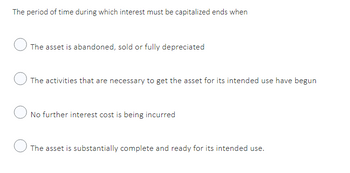
FINANCIAL ACCOUNTING
10th Edition
ISBN: 9781259964947
Author: Libby
Publisher: MCG
expand_more
expand_more
format_list_bulleted
Concept explainers
Topic Video
Question

Transcribed Image Text:The period of time during which interest must be capitalized ends when
The asset is abandoned, sold or fully depreciated
The activities that are necessary to get the asset for its intended use have begun
No further interest cost is being incurred
The asset is substantially complete and ready for its intended use.
Expert Solution
This question has been solved!
Explore an expertly crafted, step-by-step solution for a thorough understanding of key concepts.
This is a popular solution
Trending nowThis is a popular solution!
Step by stepSolved in 2 steps

Knowledge Booster
Learn more about
Need a deep-dive on the concept behind this application? Look no further. Learn more about this topic, accounting and related others by exploring similar questions and additional content below.Similar questions
- Question 2 Depreciation is the process of valuing an asset at its fair value. increasing the value of an asset over its useful life in a rational and systematic manner allocating the cost of an asset to expense over its useful life in a rational and systematic manner. writing down an asset to its real value each accounting periodarrow_forwardThe purpose of the depreciation adjustment is to: -spread the cost invested in an asset over its useful life. -show the current market value of the asset. -set up a reserve fund for purchasing a new asset. -expense the full amount of the asset in the year purchased.arrow_forwardWith regards to depreciation, which of the following is not true? O Straight Line depreciation includes initial cost and salvage value in the depreciation calculation. In straight line depreciation, the depreciation life (n) is set based on the MACRS property class. MACRS Depreciation method is the only method allowed for accounting and tax purposes. In MACRS depreciation, the salvage value is assumed to be zero. In straight line depreciation, the asset is depreciated down to a book value equal to the salvage value.arrow_forward
- Which of the following is true? O The book value at the end of an asset's useful life will be the same under all the depreciation methods allowed under generally accepted accounting principles. The annual depreciation expense will usually differ under the various depreciation methods. The total depreciation in the accumulated depreciation account will be the same at the end of the asset's useful life under all the methods allowed under generally accepted accounting principles. O All are true.arrow_forwardFair value as a method of asset measurement is defined as: Multiple Choice O O the cost of an asset adjusted for the depreciation or amortization accumulated over its lifetime. price that would be received to sell assets in an orderly transaction between market participants on a given date. the net amount of cash into which an asset could be converted in the ordinary course of business. the value of what is given in exchange for the asset at its initial acquisition.arrow_forwardTRUE OR FALSE The term used to describe the mechanical process of allocating the cost of an intangible asset to expense over the shorter of the legal life or estimated useful life is called amortization.arrow_forward
- IFRS requires annual reviews of long-lived assets (other than goodwill) for reversal indicators. A loss may be reversed up to the newly estimated recoverable amount, not to exceed the initial carrying amount adjusted for depreciation. This is a significant departure from GAAP, so what are the financial statement implications? Is it a good thing or bad?arrow_forwardThe impairment test for goodwill is conducted based on the cash-generating unit to which the goodwill has been assigned. After an impairment loss is recorded for goodwill, the recoverable amount becomes the basis for the impaired asset and is used to calculate amortization in future periods. options : both statement false first statement true and second statement false fisrt statement false and second statement ttrue . both sttament truearrow_forwardIntangible assets are amortized when: There is no more depreciation available to take. It has a finite life. It has an infinite life. The value has been impaired.arrow_forward
- Choose the appropriate definition for each term. Term Accelerated depreciation Goodwill Patent EBITDA Net book value Fixed assets Straight-line depreciation Residual value Trademark Definitionarrow_forwardLimited-life intangibles are amortized over their useful life or economic life whichever is shorterarrow_forwardE4arrow_forward
arrow_back_ios
SEE MORE QUESTIONS
arrow_forward_ios
Recommended textbooks for you

 AccountingAccountingISBN:9781337272094Author:WARREN, Carl S., Reeve, James M., Duchac, Jonathan E.Publisher:Cengage Learning,
AccountingAccountingISBN:9781337272094Author:WARREN, Carl S., Reeve, James M., Duchac, Jonathan E.Publisher:Cengage Learning, Accounting Information SystemsAccountingISBN:9781337619202Author:Hall, James A.Publisher:Cengage Learning,
Accounting Information SystemsAccountingISBN:9781337619202Author:Hall, James A.Publisher:Cengage Learning, Horngren's Cost Accounting: A Managerial Emphasis...AccountingISBN:9780134475585Author:Srikant M. Datar, Madhav V. RajanPublisher:PEARSON
Horngren's Cost Accounting: A Managerial Emphasis...AccountingISBN:9780134475585Author:Srikant M. Datar, Madhav V. RajanPublisher:PEARSON Intermediate AccountingAccountingISBN:9781259722660Author:J. David Spiceland, Mark W. Nelson, Wayne M ThomasPublisher:McGraw-Hill Education
Intermediate AccountingAccountingISBN:9781259722660Author:J. David Spiceland, Mark W. Nelson, Wayne M ThomasPublisher:McGraw-Hill Education Financial and Managerial AccountingAccountingISBN:9781259726705Author:John J Wild, Ken W. Shaw, Barbara Chiappetta Fundamental Accounting PrinciplesPublisher:McGraw-Hill Education
Financial and Managerial AccountingAccountingISBN:9781259726705Author:John J Wild, Ken W. Shaw, Barbara Chiappetta Fundamental Accounting PrinciplesPublisher:McGraw-Hill Education


Accounting
Accounting
ISBN:9781337272094
Author:WARREN, Carl S., Reeve, James M., Duchac, Jonathan E.
Publisher:Cengage Learning,

Accounting Information Systems
Accounting
ISBN:9781337619202
Author:Hall, James A.
Publisher:Cengage Learning,

Horngren's Cost Accounting: A Managerial Emphasis...
Accounting
ISBN:9780134475585
Author:Srikant M. Datar, Madhav V. Rajan
Publisher:PEARSON

Intermediate Accounting
Accounting
ISBN:9781259722660
Author:J. David Spiceland, Mark W. Nelson, Wayne M Thomas
Publisher:McGraw-Hill Education

Financial and Managerial Accounting
Accounting
ISBN:9781259726705
Author:John J Wild, Ken W. Shaw, Barbara Chiappetta Fundamental Accounting Principles
Publisher:McGraw-Hill Education